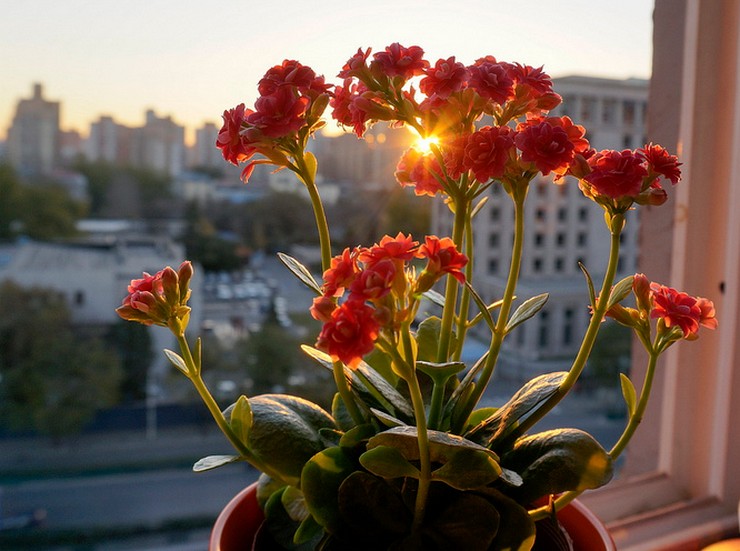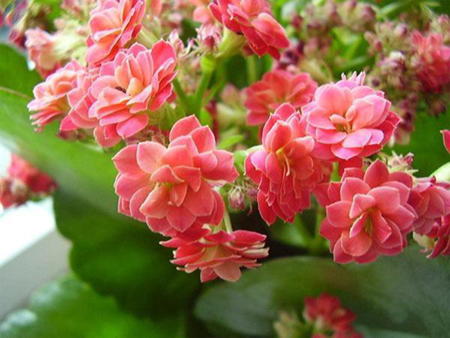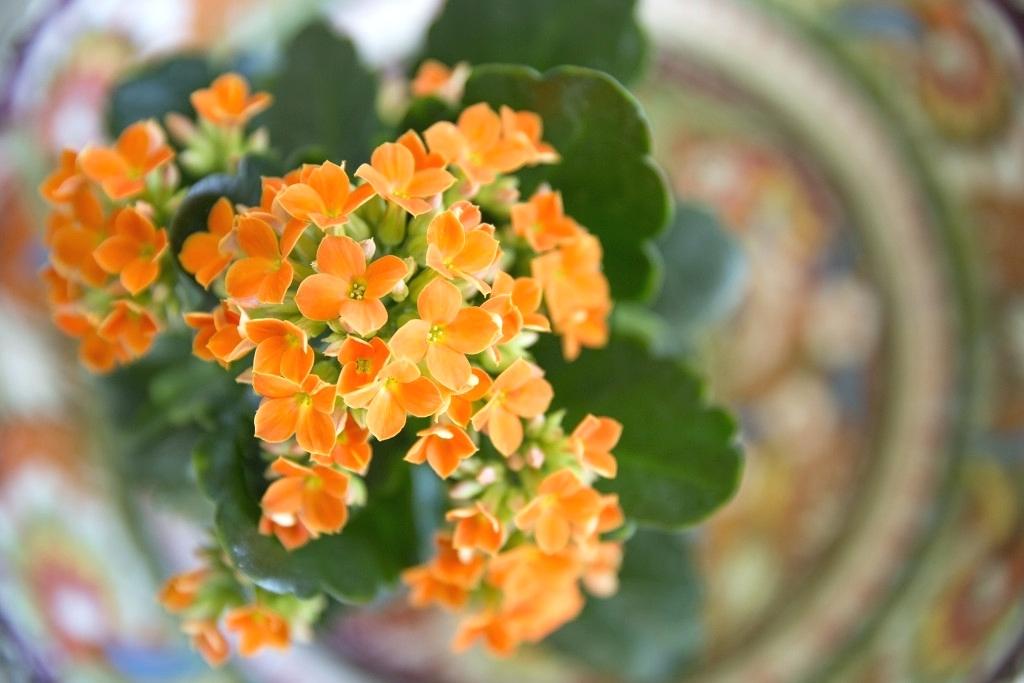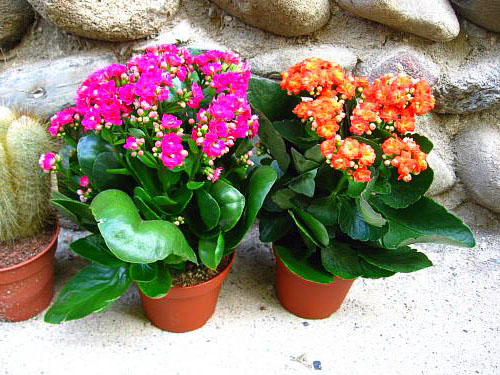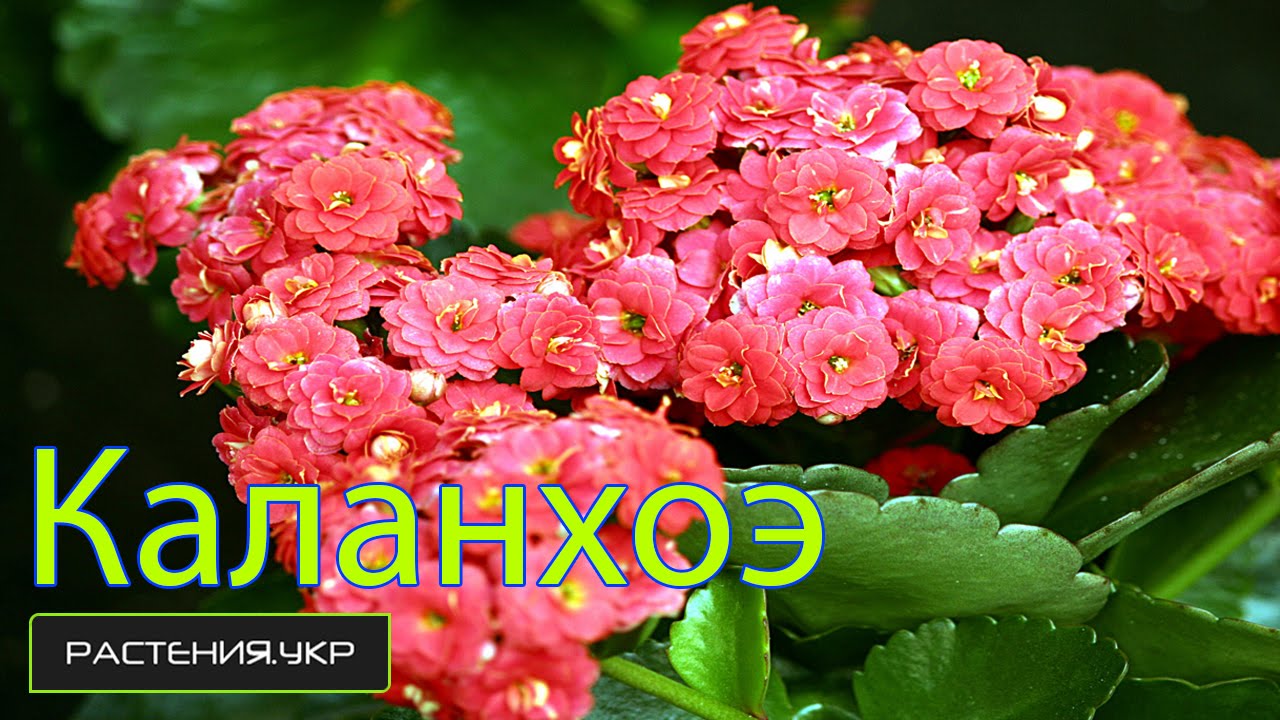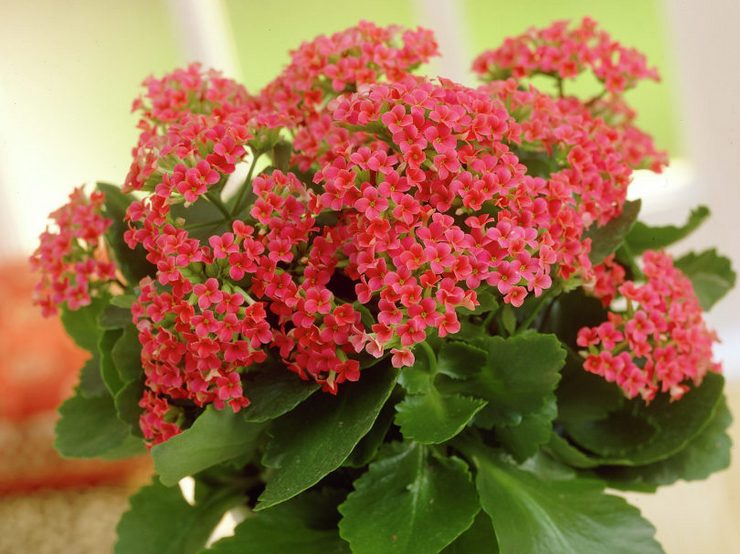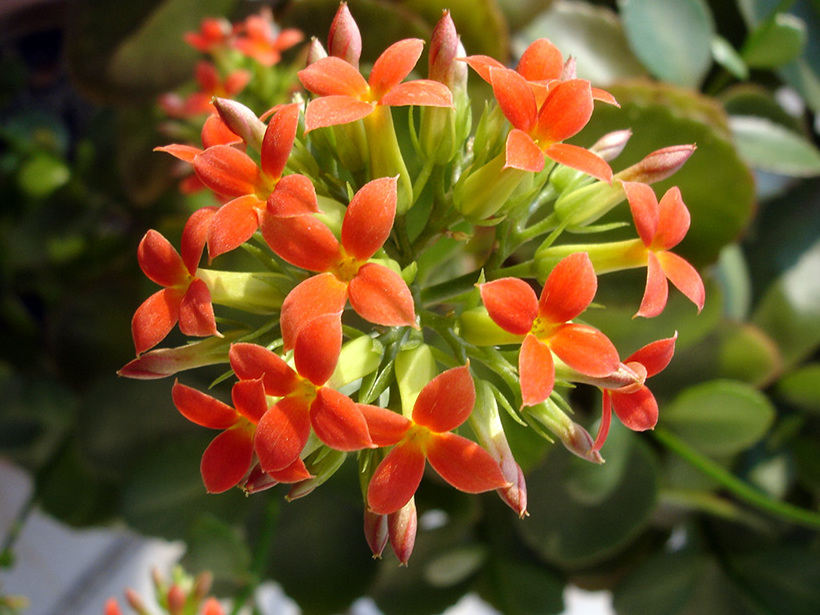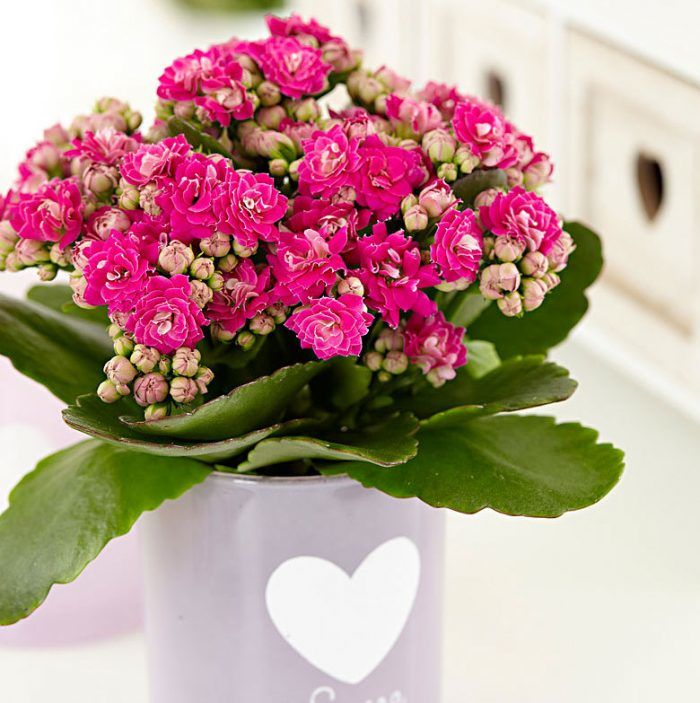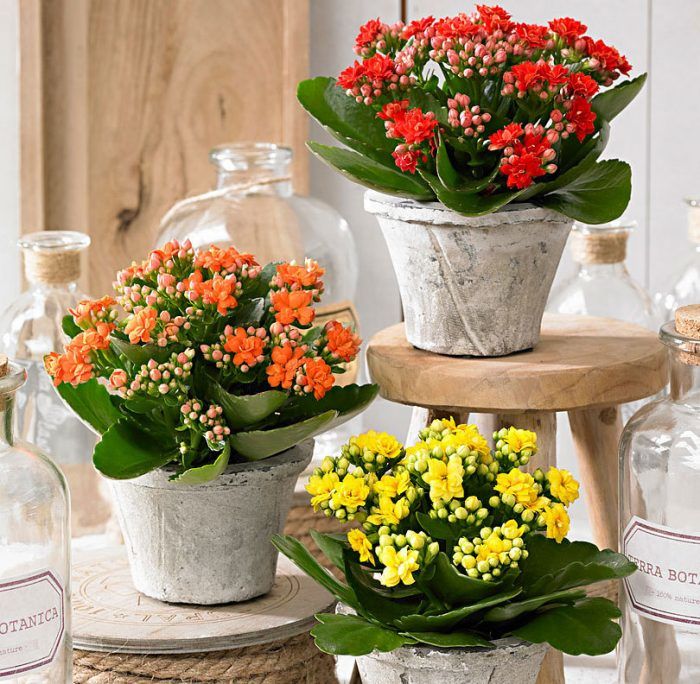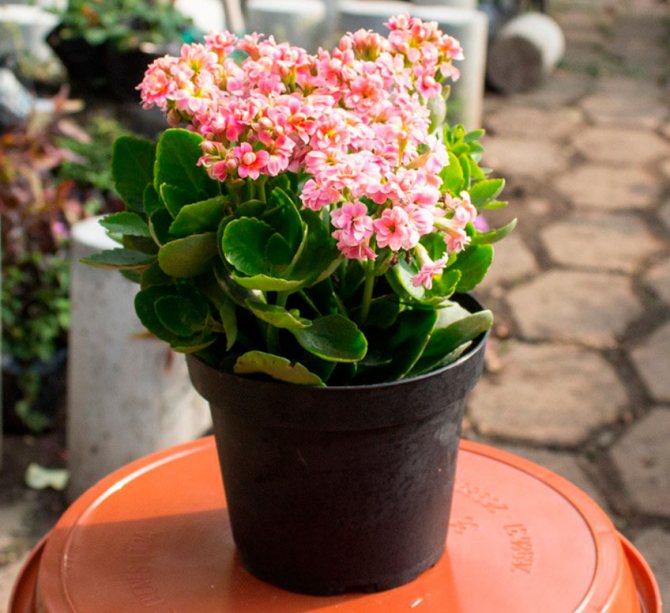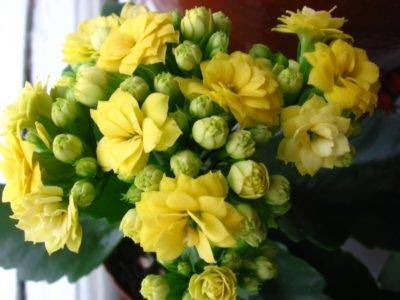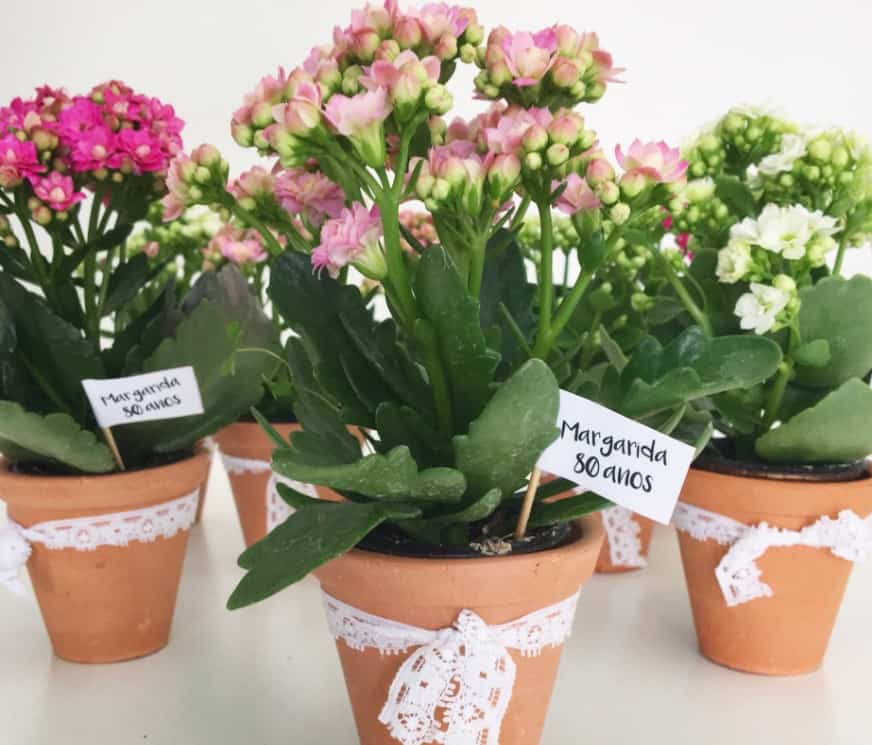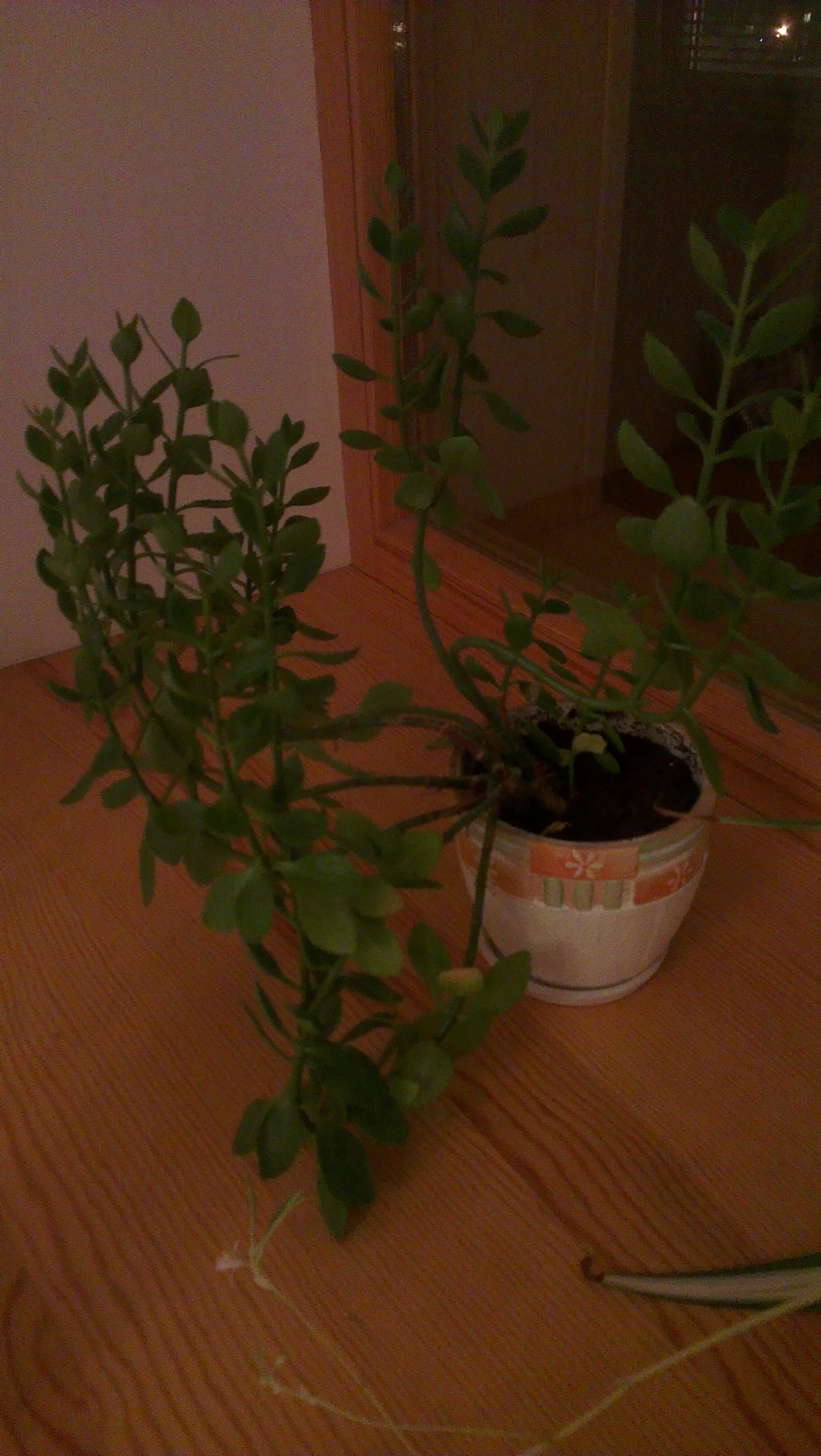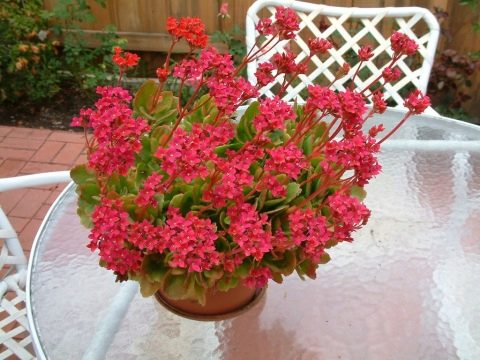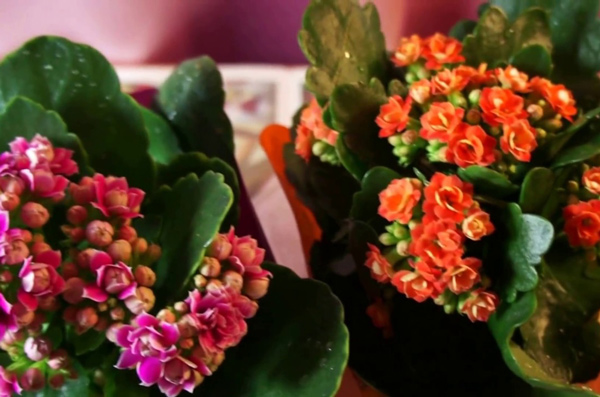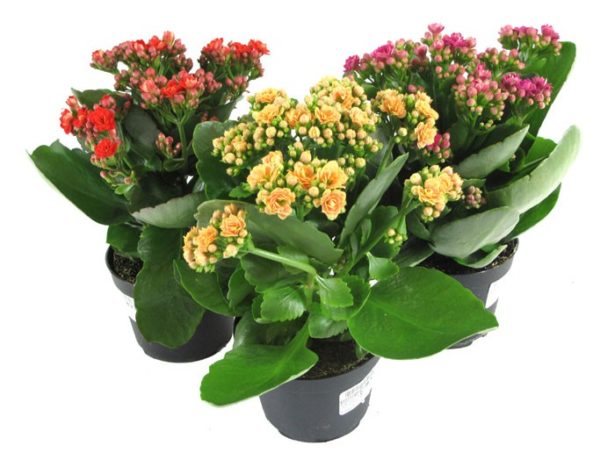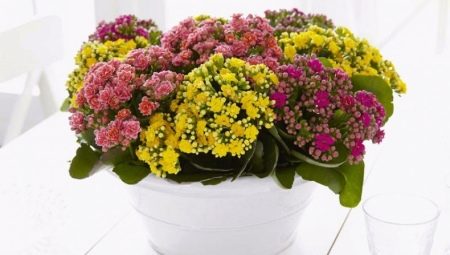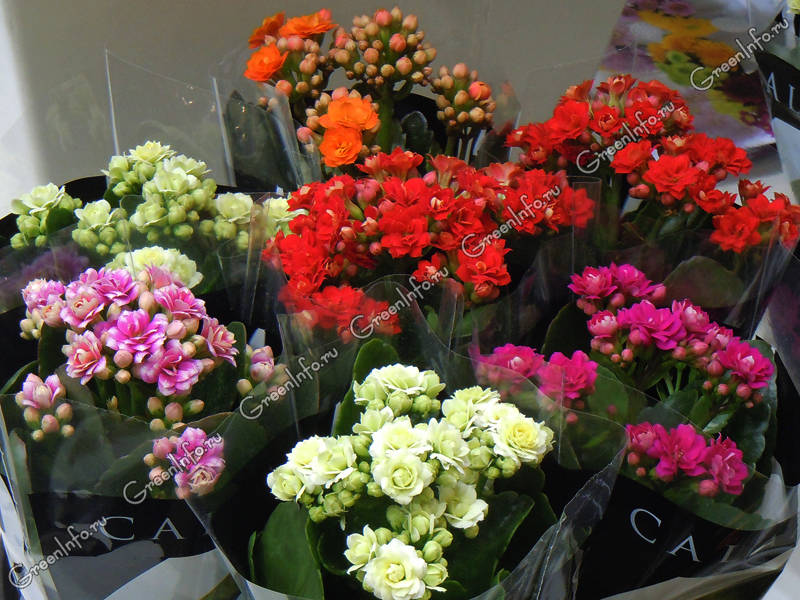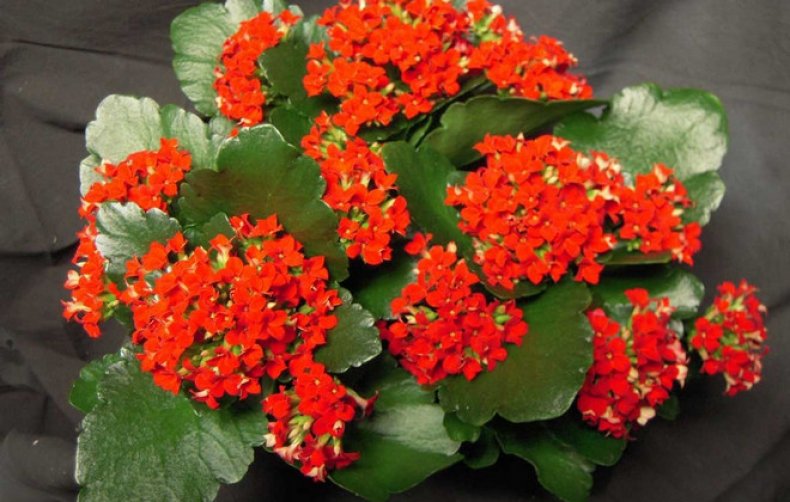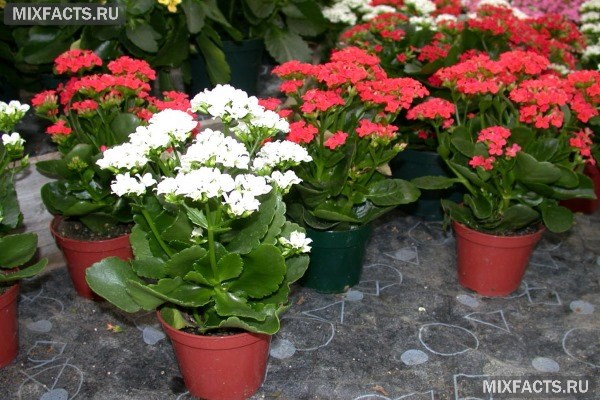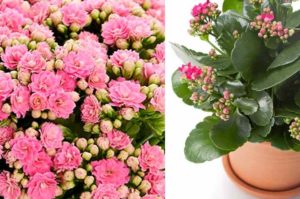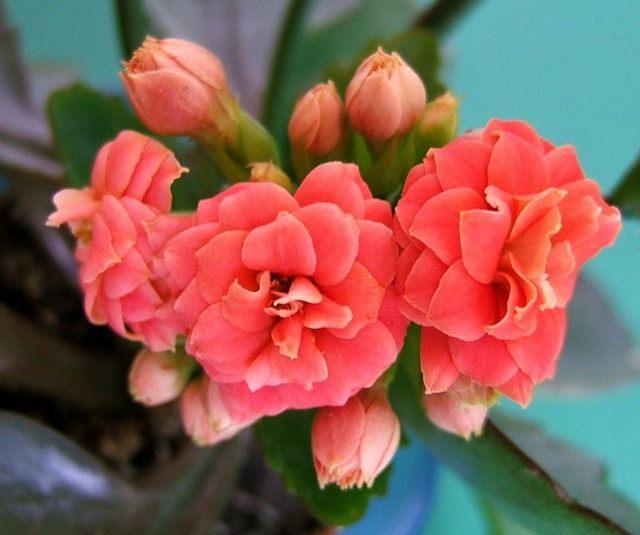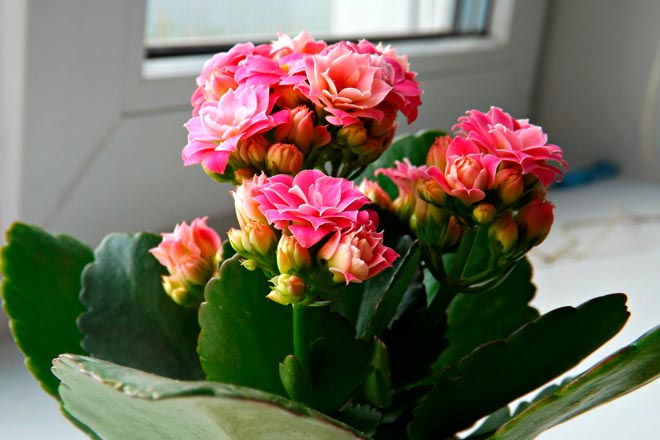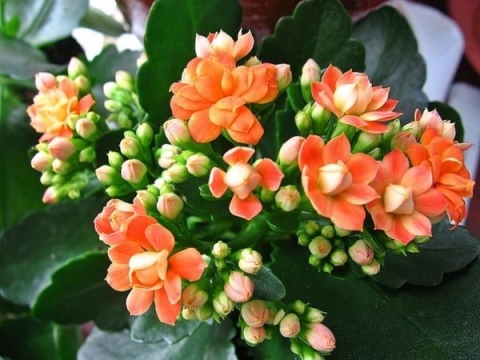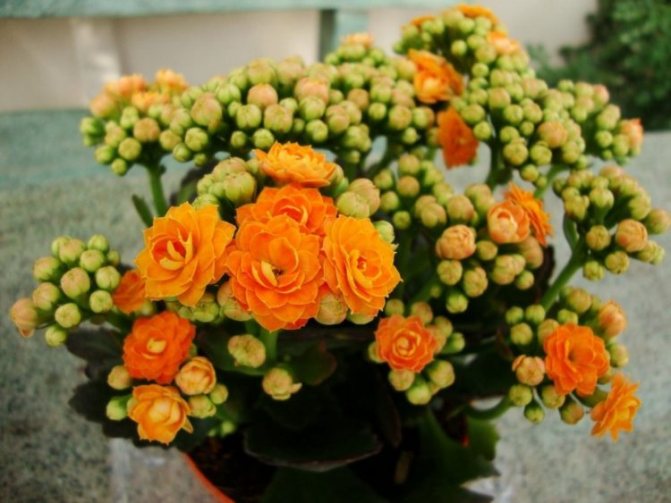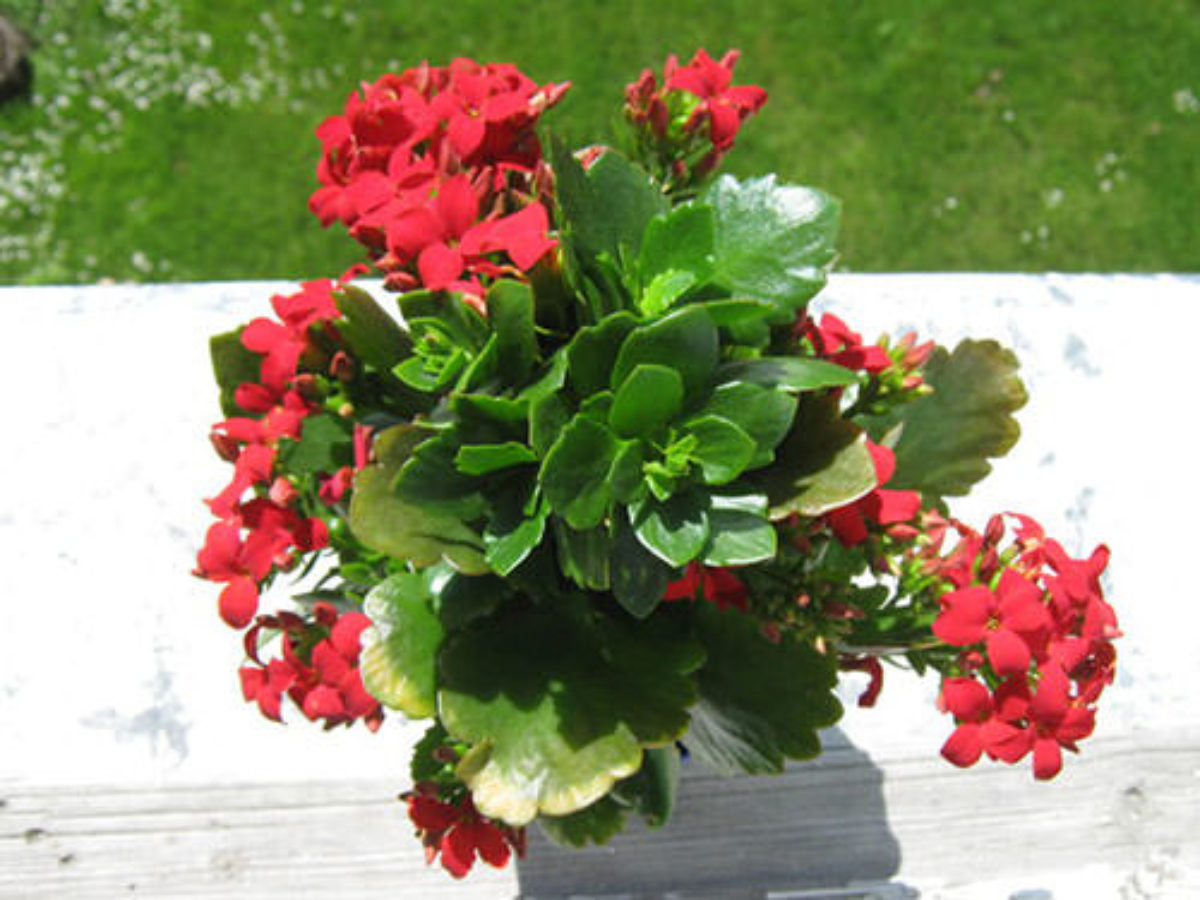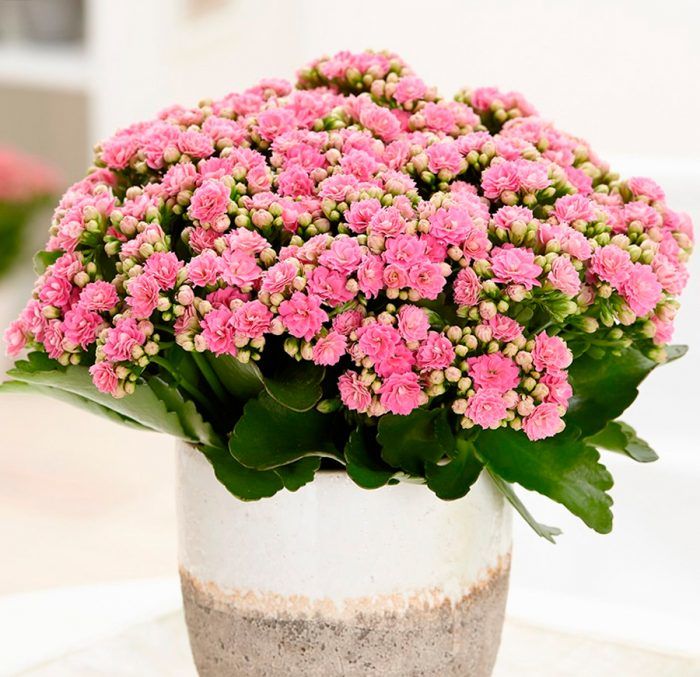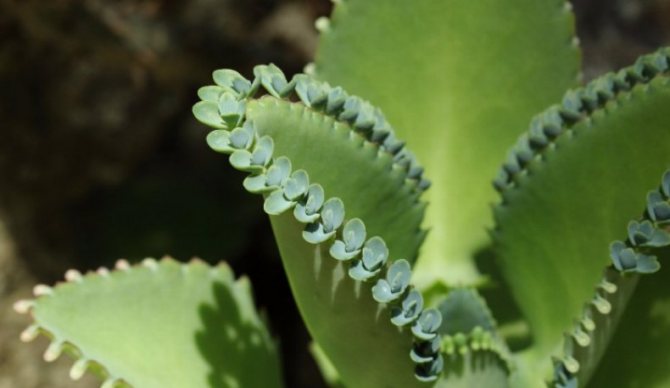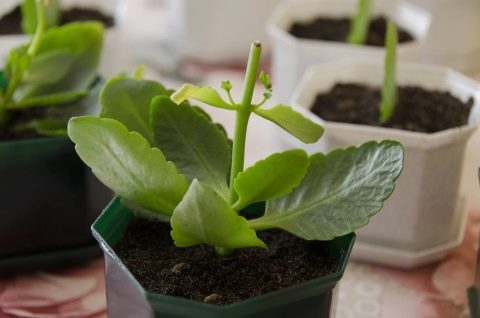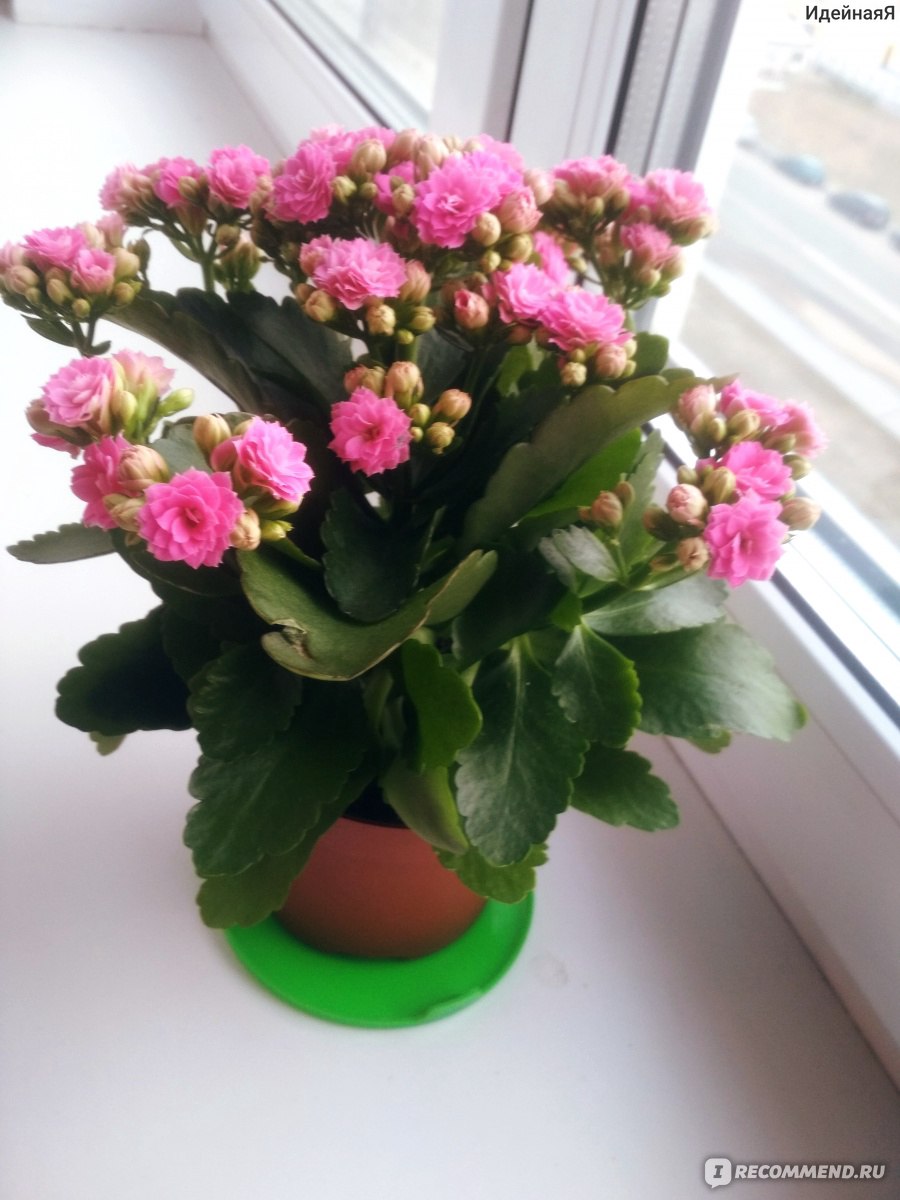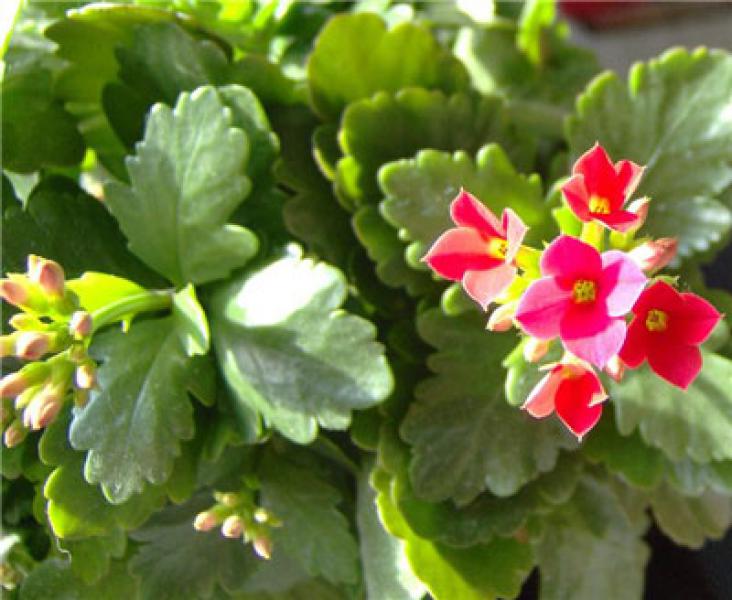Care after purchase
Kalanchoe Kalandiva after the move needs to adapt to new conditions. The purchased plant should be kept separate from other indoor plantings for some time. Usually, 6-7 days are enough for Kalanchoe adaptation. At this time, you should make sure that the plant does not have diseases and pests. Yellowing thin leaves will tell you about their presence.
If everything is in order with the flower, it is advisable to transplant it a week after purchase. This is necessary in order to provide the plant with high-quality soil and more comfortable conditions for its growth. In the future, it will definitely not be difficult for you to give the plant the care it needs. At home, Kalanchoe Kalandiva is very easy to grow. Indeed, in fact, the chicks are completely picky and easily adapts to any situation.
Description of the plant
Kalanchoe Blossfeld is a perennial flowering herbaceous succulent from the Tolstyankov family. This ornamental plant is about 30-50 cm high. Its numerous weakly branching stems are decorated with smooth bright green leaves of a round or ovoid shape. Their size is quite large (up to 7 cm long and 4 cm wide). The edges of the leaf plates are crenate, may be framed with a reddish border.

With the onset of winter, the plant enters the flowering phase. On long pedicels, small delicate buds begin to bloom, painted in various shades: pink, red, white, orange or yellow. Their size usually does not exceed 1 cm in diameter. Gathering in lush racemose inflorescences, they transform the plant literally before our eyes.
Flowering lasts 5-7 months. In May, the Kalanchoe, as a rule, enters a resting phase. The plant accumulates strength in order to use them to form new flowers.
During this period, you can notice a significant increase in deciduous mass. Blossfeld's Kalanchoe juice contains substances that are toxic to pets. It is recommended to place the plant in places that are not accessible to pets.
Conditions of keeping and caring for Kalanchoe at home
Like almost all succulents, Kalanchoe Kalandiva does not cause serious trouble for owners, with the exception of some care features, on which the entry of the plant into the flowering time depends. And here the organization of lighting plays the greatest role for the flower culture.
Therefore, for a pot with a plant, it is optimal to choose a place on a windowsill facing east or west. If this is not possible, the northern windows will have to provide good lighting for the Kalanchoe, and shade the bushes on the southern windows. Kalanchoe Kalandiva blooms in the darkest period of the year. A plant, unlike many crops, does not need more than 9 hours of daylight, but backlighting in cloudy weather is simply necessary. Moreover, both the lack of light and its excess can lead to the "refusal" of the plant from laying buds.
In fact, one has only to establish the proper lighting regime, provide the bush with watering, a suitable temperature and feeding, as the Kalanchoe will certainly please with lush double bouquets on the tops of the shoots. The special temperature regime of Kalanchoe Kalandiva is not required. In summer, the flower feels great indoors, on a terrace or veranda, where the air is warmed up to 18 to 28 ° C. Such unpretentiousness allows you to take Kalanchoe pots into the garden and even organize seasonal gardening with their help.
On this topic:
BACK
FORWARD
1 of 61
How to care for Kalanchoe so that the plant will delight with flowers? In autumn, when the plants are to form flower buds, the temperature for the Kalanchoe is lowered to 14–16 ° C.At this time, it is important to reduce the intensity of watering, since roots sensitive to excess moisture can rot at low temperatures:
- When watering in the fall, a barely noticeable wilting of leaves may become a sign of the need for watering.
- In other periods of the year, it is better to focus on the condition of the soil under the plant. If the soil is dry a couple of centimeters, this should be a sign that Kalanchoe Kalandiva needs water.
During the heating period, the plant may not be sprayed additionally, but you need to arrange a small shower for the foliage. This will have a beneficial effect on metabolic processes, chlorophyll synthesis and Kalanchoe growth.
Such a measure will not only return the appearance of the bush, but also awaken new points of growth, stimulate the appearance of more inflorescences.
Sometimes the absence of flowers causes excessive care of the Kalanchoe at home, namely, excessive feeding of the plant with nitrogen, which causes the active growth of greenery. When choosing a fertilizer mixture for this crop, it is better to be guided by the presence of phosphorus and potassium in the mixture. These elements are essential for the Kalanchoe for long-term mass flowering.
As a ready-made product, you can pay attention to fertilizers for succulents and flower indoor plants.
During flowering, the roots practically do not grow, and any manipulations with the bush can lead to the loss of flowers and buds. Therefore, it is better to transplant Kalanchoe Kalandiva mini or another variety during the rest period, not more often than after 2-4 years. There are no special requirements for the soil for the Kalanchoe. The main quality of the soil is looseness and considerable lightness. You can take it as a ready-made mixture for succulents or flowering plants, adding a quarter of the volume of washed sand to the last soil.
The easiest way to propagate Kalanchoe Kalandiva is by cuttings obtained when cutting an adult bush:
- Parts of the plant take root so easily that you can use not only a nutritious substrate, wet sand, but even plain water for this.
- Within a week, roots are formed, sufficient for transplanting the cuttings to a permanent place. In this case, the aerial roots on the shoot take on the role of ordinary ones.
- Kalanchoe will be ready to bloom with proper care at home in about six months.
If you are patient, you can get young plants from individual Kalanchoe leaves. To do this, a leaf torn off with a petiole is slightly dried and rolled halfway into a suitable soil. After some time, tiny rosettes will appear on the grooves along the edge of the leaf, which, as they grow and the roots appear, can be separated and planted for growing.
New bushes can also be grown from small seeds, sometimes ripening at home, but they may not meet the expectations of the grower, since the hybrid Kalanchoe Kalandiva mix sold in stores, in this case, do not retain parental features.
Varieties of Kalanchoe
Almost all varieties, in one form or another, originate from several of its main subspecies.
They have a lot in common, however, there are important differences that should be mentioned in order to most fully describe the features of growing this plant in a modern apartment or house.
Kalanchoe Blossfeld
Blossfeld
This small plant rarely exceeds 35 cm in height. It has oval leaves with slightly serrated edges.
Sometimes the end of the leaf edge has a reddish tint. Blossfeld's main feature is its flowering ability.
It is quite long and occurs at a time unusual for most plants. Flowering of this Kalanchoe subspecies begins in January and can last until the end of May.
The plant is unpretentious, tolerates droughts and transplants well.
Kalanchoe Kalandiva
Kalandiva
It is a very interesting variety from the point of view of appearance: a high density of flowers sometimes leads to the fact that their volume significantly exceeds the amount of deciduous mass of a plant.
The flowers are quite small, however, they are collected in large, beautiful inflorescences. Among lovers of decorative varieties of Kalanchoe, this particular variety is very popular.
It also blooms for a long time (sometimes up to six months) differs from Blossfeld in smaller size and leaves with a more shiny surface. In addition, this species has a large number of flower shades: from yellow to bright red.
Kalanchoe Cirrus
Pinnate
Has a more complex structure of leaves, along the perimeter they have a lot of "notches". Flowers of this subspecies have a panicle-shaped inflorescence.
The color is dominated by red or purple colors, but numerous hybrids can have shades from pink to purple; leaf color also ranges from light green to purple.
Kalanchoe Degremona
Degremona
When they talk about Kalanchoe, in most cases they mean this particular variety. This is the most familiar to the florist, one might say, the classic version of the plant.
Its most characteristic feature is a large number of "babies" (brood buds) located at the edges of its leaves. Babies form very quickly, and, having separated from the mother plant, they immediately take root, hitting the ground.
The leaves of this variety are triangular in shape, they are slightly curved inward.
The plant has truly fantastic abilities for growth and reproduction: its growth is practically unlimited, and, often, its upper part can break off under its own weight.
In order to maintain the plant in normal shape, it is necessary to regularly cut off its top and remove excess "babies".
Anemones: 25 species, features of reproduction and care, planting in open ground, forcing in winter, description of the medicinal properties of the plant (50+ Photos & Videos) + Reviews
Plant care
Blossfeld's Kalanchoe does not require any special care at home. The soil requirements of this flower, like other succulents, are small.
The soil must be selected light, consisting of sand or perlite, peat or humus and sod land, which are taken in equal shares. At the bottom of the flowerpot, you need to put good drainage.
Top dressing is carried out all year round and is combined with watering. They are brought in once every 2 weeks in the summer and every 3-4 weeks in the winter.
If the Kalanchoe develops and blooms normally, it is enough to limit yourself to a standard fertilizer for succulents containing trace elements.
Weak formation of flower buds signals a lack of phosphorus salts, insufficient development of the leaf apparatus - a deficiency of nitrogen nutrition.
Air humidity does not greatly affect the flower, although excessive dampness harms it.
With a moisture content of more than 80%, spotting appears on the leaves and buds, they can die off. Kalanchoe tolerates dry air well. Light spraying is needed for the plant only occasionally.
The optimum temperature for keeping Kalanchoe Blossfeld is 17-20 ℃ in the cold season and about 25 ℃ in summer. Too hot days with temperatures of about 30 ℃ will be unfavorable: the plant will tolerate them without visible harm, but it will lose a lot of strength.
Cold snaps are not so critical, but temperatures below 4-6 ℃ should be avoided: a native of Madagascar may not survive such conditions.
The light regime is most important for the Kalanchoe. Of course, the flower will grow at any level of illumination and length of the day, but flowering is tied precisely to these conditions.
In winter, during the period of active flowering, the plant needs bright light.
The ideal position is a south window. In summer, less light is needed and the Kalanchoe is rearranged to the western or eastern window. The duration of lighting is also important. The signal for bud formation is a short day.
Preparation for flowering in Kalanchoe begins after the length of the day becomes less than 12 hours. To stimulate flowering, you need to shorten the duration of the lighting.
To do this, from September, the flower is covered with an opaque cap, creating a daylight hours for it with a duration of 9-10 hours.In such conditions, it will bloom just in time for Christmas and New Year, which makes it a wonderful gift for the holidays.
Pruning is done after the plant has faded.
The peduncle is cut as low as possible, to the first large leaves. As a result, conditions will be created for the establishment of new flowering shoots. Old elongated specimens also need pruning. Their tops are cut off, which can then be rooted.
Varieties
- Kalanchoe blossfeldiana "Variegata" variety with a white border on the leaves.
- Kalanchoe blossfeldiana "African" variety with lanceolate and deeply cut leaves.
- Kalanchoe blossfeldiana "Yellow" variety with yellow flowers.
- Kalanchoe blossfeldiana "Scottie Don Juan" variety with red flowers.
- Kalanchoe blossfeldiana "Singapore" is a cultivar with red flowers.
- Kalanchoe blossfeldiana "Rose Flower Lea" variety with double and yellow flowers.
- Kalanchoe blossfeldiana "Leonardo" variety with double flowers.
- Kalanchoe blossfeldiana "Red Star" variety with red flowers.
Kalanchoe "Kalandiva" is one of the most beautiful varieties of Blossfeld.

Kalanchoe variety "Kalandiva" belongs to the most common and most beautiful Kalanchoe, which pleases with the beauty of flowers, reminiscent of small pink double roses. New varieties of Kalanchoe Blossfeld derived from the Leonardo variety.
- "Goldengirl", "Brazil", "Jamaica" - yellow flowers;
- "Tate," Red "," Fiesta "- red flowers;
- "Hawn", Greco "," Rio "- orange flowers;
- "Monroe", Casablanca - white flowers;
- "Loren" - pink flowers.
Kalanchoe - home care
Lighting
For normal growth, any place in the house is suitable, where even a little sunlight falls. The plant grows well in partial shade or when exposed to diffused sunlight.
When exposed to direct sunlight, the color of the leaves at the edges will change, they become reddish.
The ideal place in the house would be east or west window, with not very intense lighting. Blooming Kalanchoe prefers an east or southeast window.
During the flowering of the Kalanchoe in the spring and autumn, additional lighting will be needed.
Not enough light leads to stretching of plants, the upper leaves turn pale and the lower ones die off.
Temperature
The plant tolerates temperature changes calmly. Therefore, already starting from 10 degrees, it can be taken out into fresh air. In the summer-autumn period, the plant can be left on the balcony.
The plant tolerates the heat in the summer months well, but it is necessary to increase the frequency of watering.
The following temperature is considered optimal: in summer 23-25 degrees, in winter 12-16 degrees.
Watering
Kalanchoe accumulates moisture in the leaves, and tolerates drought or, for example, your absence. Plants are afraid of stagnant water.
Watering must be done abundantly in order to wet the entire clod of earth, but the remaining moisture must be drained.
For yourself, decide on the correct frequency of watering, the earthen lump should dry out between waterings.
Most often, watering is carried out in the summer heat, in winter the interval between waterings is 10-14 days.
If you pour the plants, the roots will begin to rot, various rot and fungi will appear.
Humidity
At home, Kalanchoe does not need to be sprayed. It is especially dangerous to spray in winter. If the leaves are covered with dust, the best way to get rid of it is to wipe with a damp cloth or, alternatively, wash in the shower.
Pruning
In order for the plants to bloom, it is necessary to cut off radically. Cut the flower stalks as low as possible so that the remaining parts do not rot.
Any bad looking and old parts of the plant must be removed. Young and strong shoots, after pruning, are suitable for reproduction.
In summer, pinch the tops to form lateral shoots and protect the plant from overgrowing.
Top dressing
About 1 time per month, Kalanchoe needs to be fed using fertilizers for succulents.
For flowering Kalanchoe, use complex fertilizersotherwise the plant will not bloom.
Attention: an excess of fertilizers is dangerous for the Kalanchoe. It is better, when feeding, to dilute half the dose or a third according to the instructions of the drug used
Do not feed in winter
It is better to dilute half the dose or a third when carrying out feeding according to the instructions of the drug used. Do not feed in winter.
Reproduction
Kalanchoe belongs to fast-growing plants, therefore it multiplies easily.
For breeding suitable young shoots that remain after pruning or cut off specifically for reproduction.
Shoots are approximately 10-12 cm long. 4-6 lower leaves are removed on them and planted to such a depth in a pot with loose, fertile soil.
Roots will appear from the sinuses of the torn off lower leaves in the ground. After planting, compact the soil around the shoot and water along the edges of the pot (so that the shoot withers a little in the ground, all other watering should be done as usual, over the entire surface).
There is no need to cover the plant during reproduction. Place the pot in a warm place with partial shade.
Transfer
Plants require annual replanting in late March... Mature plants can be transplanted every 3 years or sprinkle with fertile soil, provided that the roots do not look beyond the boundaries of the pot. You can also transplant after flowering.
For transplanting, you need to pick up a pot 2-3 cm larger than the previous one in diameter
Remove the flower carefully when transplanting so as not to damage the plant.
Pests
Of the pests, the scale insect, spider mite and mealybug can attack the Kalanchoe.
Mealybug removed with a wet cloth soaked in alcohol.
In the fight against scabbard and tick insecticide treatment will help. A good remedy is Fitover, does not harm humans and pets.
Reproduction
Kalanchoe can be propagated by leaves, shoots, top and seeds. Seeds are sown in spring, covering the container with glass. Cuttings are cut in May-June and rooted when the slices are dry. The soil must be permeable. It is worth using a rooting agent. Seedlings can be rooted in water.
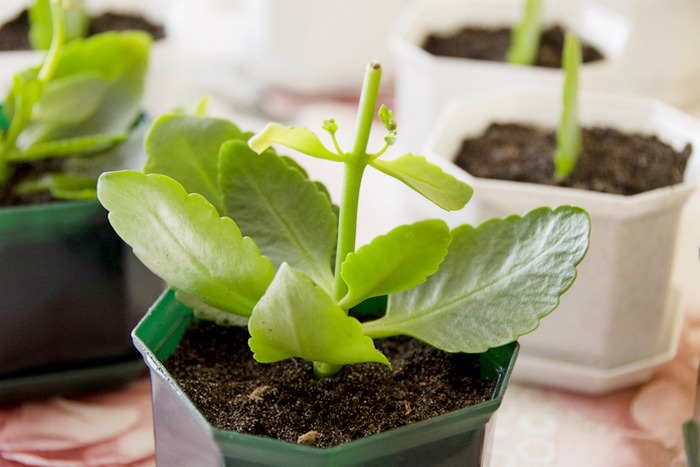
The most common growing problems
It is not difficult to grow Kalanchoe at home, using the above rules, you can enjoy the flowering plant more than once a season. The most common problems encountered when growing Blossfeld's Kalanchoe is plant decay resulting from over-watering. It is worth noting that it is better to water less than overflow. Kalanchoe is a succulent with fleshy leaves and shoots, if it starts to rot, it will only be suitable for discarding. In the absence of watering, the leaves begin to dry out and fall off.
In too shaded places, the plant stretches unnaturally, the leaves become brighter.
Powdery mildew can appear from diseases: it will manifest itself as a whitish bloom on the leaves and shoots, and powdery downy mildew will appear as dark spots on the shoots. In addition to powdery mildew, gray rot may appear, which is facilitated by excessive moisture and cold.
Pests that may appear are aphids, thrips, scale insects and scale insects.
Concluding remarks
Kalanchoe (Kalanchoe) belongs to the Fat family
In addition to the species under discussion, it is worth paying attention to the Kalanchoe Bekharskoe, called "elephant grass". This is a beautiful, original plant, impresses with an interesting structure.
Consists of a massive central shoot on which fleshy, large, gray or brownish, triangular leaves with a bloom are planted. Reaches more than a meter in height. It is worth mentioning the more popular felt Kalanchoe, characterized by fleshy, lanceolate leaves covered with hairs. This small plant grows up to 20 cm in height. And the Kalanchoe is narrow-leaved, characterized by narrow, more tubular leaves, collected on a long main shoot.
Reproduction
Seed propagation is used when growing old varieties and for breeding new ones. Kalanchoe seeds are very small, they are sown on the surface of a well-prepared substrate. Slightly acidic peat soil is mixed with sand or perlite in equal proportions, steamed, filled with prepared boxes and moderately moistened. Seeds are sown in rows, lightly pressed, but not sprinkled with soil. After sowing, the box is covered with a transparent film or glass, placed in a bright diffused light. At a temperature of + 20 + 22 ° C, sprouts appear on the 10th day.After the seedlings appear, the film or glass must be removed.
By sowing seeds in March, you can get a small flowering plant in December. Sowing seeds in January will allow you to get a full-fledged flowering plant in winter. For the normal growth of seedlings from January to the end of March, it is necessary to provide it with additional lighting according to the scheme of 12-hour daylight hours.
The Kalanchoe has a rather short juvenile period, up to 8 pairs of leaves, during which stimulation with short days will not lead to flowering. After this age, the plants will be ready to set flower buds.
Vegetative reproduction. For most modern varieties, a vegetative propagation method is used, in which all the characteristics of the original plant are preserved.
For this, top cuttings 5-8 cm long are taken. The bottom pair of leaves is removed. For 1-3 days, the cuttings are allowed to air dry in the shade. Rooting hormones are optional. The rooting substrate is made up of equal shares of slightly acidic peat soil and perlite or sand. The soil is pre-steamed to destroy pests and pathogens. For the convenience of rooting control, the prepared soil is laid out in transparent disposable cups with drainage holes made. The lower part of the cutting is immersed in the soil, from where the leaves were removed. Cuttings are often sprayed so that the leaves do not lose turgor or are placed in a spacious greenhouse with regular ventilation. The optimum temperature for rooting is about + 21 ° C, bottom heating is desirable. Cuttings give roots in 2-3 weeks. Young plants obtained from cuttings do not have a juvenile period and are ready almost immediately for flowering induction.
Kalanchoe can also be renewed from leafy cuttings. A separate leaf is cut off, planted in the ground and covered with a transparent cap, after rooting, small children are formed on it, which over time can grow into full-fledged plants. But it will take much longer than rooting stem cuttings.
Read more in the article Cutting indoor plants at home.
Pests and diseases

All varieties of Kalanchoe are unpretentious in care and have high resistance to various diseases and pests. Only improper care can provoke the appearance of pests and diseases. Excessive watering and waterlogging are especially negative. Kalanchoe Blossfeld, in such a situation, is susceptible to various bacterial or viral diseases. Spraying the leaves of the flower with fugicides will help get rid of them.
Of the pests, this plant can be attacked by aphids, which infect the lower leaves. It should be fought with soapy water or insecticides. To grow at home, the Blossfeld variety requires very little - proper care. If you adhere to the above recommendations, then the plant will delight you with lush flowering and the absence of diseases and pests. In addition, you will receive not only a beautiful decorative flower, but also a “home doctor” that will help you cure many diseases.
Features of the conditions for Blossfeld's Kalanchoe at home and caring for him
Kalanchoe, like other succulents grown indoors, are extremely sensitive to light. Even with a short day regimen, the plant needs bright, but not direct sunlight.
- If the bush is under the scorching rays, its color fades, the leaves quickly wither, and dried burn spots appear on them.
- With a lack of light, the leaves become smaller, the stems become weaker, lengthen and lean. And the inflorescences on such a Kalanchoe are less dense, and there are fewer buds in them.
It is possible to guarantee comfortable lighting conditions for the Blossfeld Kalanchoe by taking care of additional artificial lighting, which will be required both in cloudy weather, and on winter days, and when plants are found on the northern windows.
Kalanchoe Blossfeld, especially during flowering and summer days, requires a lot of moisture
But here it is important not to overdo it, since stagnant water in the soil often leads to the development of rot on the roots and stem, which leads to damage or death of the bush.
On this topic:
BACK
FORWARD
1 of 61
If the soil is dry for the length of the phalanx of the finger:
- Kalanchoe needs to be watered with settled water at room temperature;
- be sure to remove excess water from the pan;
- wipe the bottom of the pot dry.
A sign of moisture deficiency for the Blossfeld Kalanchoe is considered to be lethargy of the leaf blades, yellowing of the lower leaves and dropping of buds.
For succulents, the dryness of the air in the room is not a critical factor. Therefore, at home, caring for Blossfeld's Kalanchoe does not include spraying. "Water procedures" are required only for cleaning foliage from dust.
Feeding Kalanchoe is carried out in several ways after flowering. For fertilization, a ready-made mixture for succulents is taken, which is used every two weeks until the end of summer. When the plant is growing in flower buds, it is best to limit the amount of nitrogen it receives, so as not to cause lush foliage to the detriment of flowering. Sometimes this is enough to make Blossfeld's Kalanchoe bloom.
But with a lack of nutrients, it is impossible to avoid not only refusal to lay the buds, but also yellowing, falling foliage. The Kalanchoe also has certain requirements for the temperature at which the plant would be comfortable:
- You can extend flowering and provide the bush with the most gentle atmosphere by providing a temperature of about 18-25 ° C during the day, and 15-17 ° C at night.
- During the growth period, Blossfeld's Kalanchoe perfectly tolerates temperatures from 15 to 30 ° C, which makes it possible to carry pot crops to the garden or to a lighted veranda.
But even when the air is cooled below 12 ° C or the temperature rises above 30 ° C, a slowdown in development cannot be avoided. At low temperatures, the plant goes into hibernation, it does not form buds, it reduces moisture consumption, therefore, in this case, watering is reduced or stopped altogether. In the second year of life, the Blossfeld Kalanchoe bushes grow significantly and require pruning in order to maintain a compact, neat plant shape and get the largest number of inflorescences.
The cuttings obtained from the tops of the shoots can be used for propagation of Kalanchoe Blossfeld. This is the easiest way to get new, lush blooming plants on the windowsill.
Types of Kalanchoe with a photo
The genus has about 20 species. Many types of Kalanchoe are grown at home.
Kalanchoe blossfeldiana

This species is famous for its numerous flowers, collected in an umbrella-shaped inflorescence. Flowers are located on long peduncles and are distinguished by a variety of colors. The plant to care for is very unpretentious.
Kalanchoe manginii (Kalanchoe manginii)

Ampel view. The flower is miniature (up to 15 cm) and is distinguished by exotic inflorescences that resemble small bells. Flowering usually occurs in spring.
Kalanchoe daigremontiana
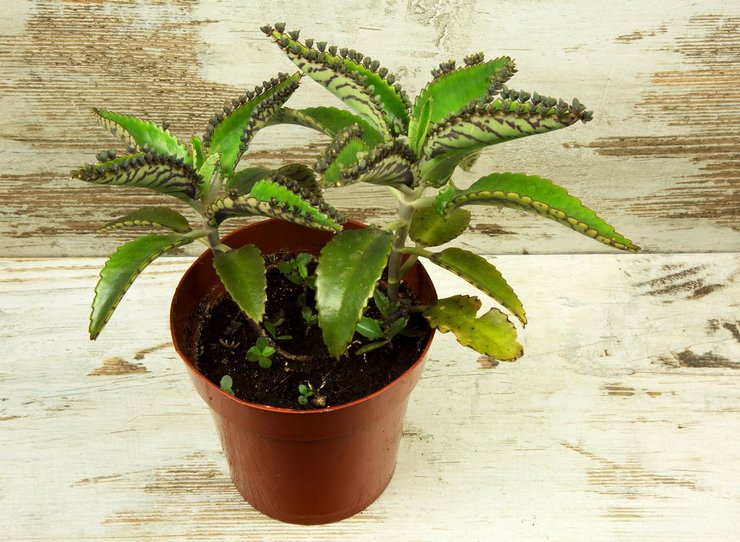
This species blooms quite rarely, exclusively in winter. Plant height reaches 50 cm. It has a straight stem and long (up to 10 cm) green triangular leaves. The leaves are strewn with many purple spots.
Kalanchoe pinnata (Kalanchoe pinnata)
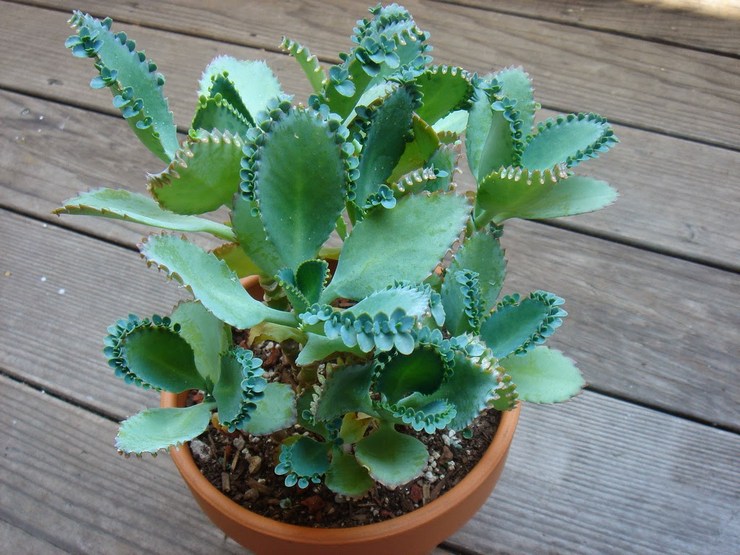
It is considered the most hardy species. It is distinguished by its height, reaching 1 m. The color of the flowers is unusual: white tones, smoothly turning into green. The juice of this type of Kalanchoe is sold at the pharmacy.
Kalanchoe bentii
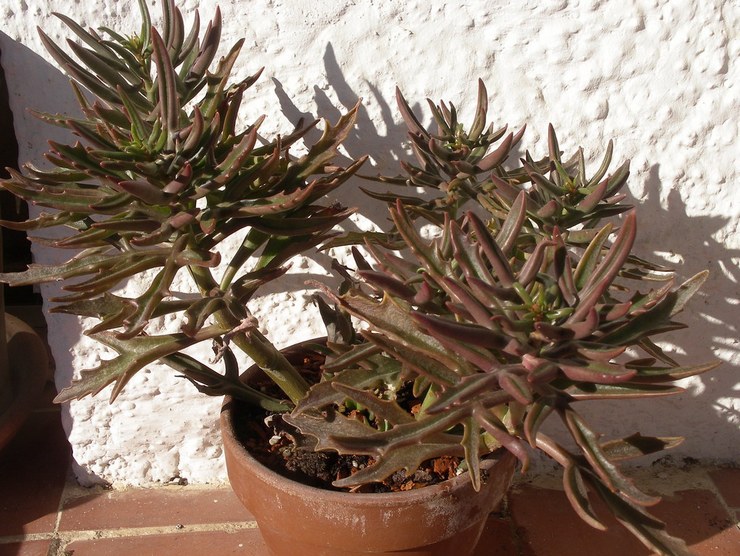
The species is represented by dwarf shrubs, reaching a height of 1 m. Leafy platinum is up to 50 cm long, rather thick and weighty. White flowers are collected in umbrella inflorescences. Flowering occurs in mid to late spring. It tolerates cultivation in cool rooms.

The species is represented mainly by shrubs. The leaves are serrated and covered with small hairs.
Kalanchoe felt (Kalanchoe tomentosa)
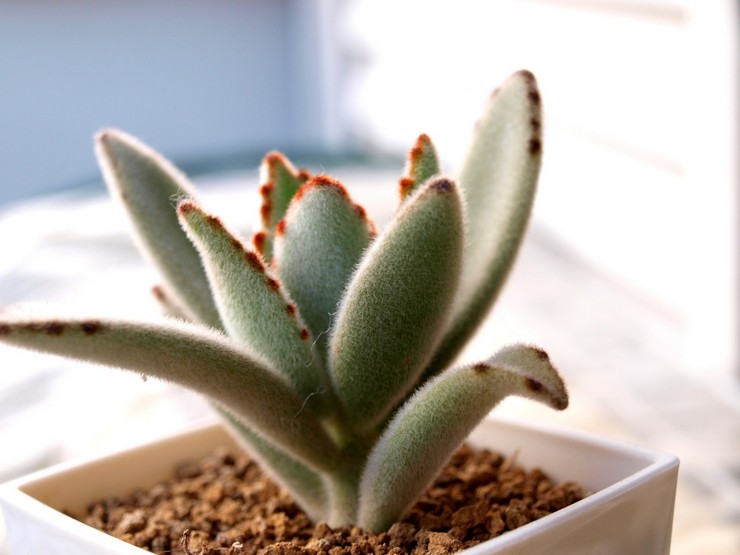
Representatives of this species are semi-shrubs.Stem erect, leaves with small hairs. Miniature flowers are collected in umbrella inflorescences.
Kalanchoe grandiflora (Kalanchoe grandiflora)

The species is also known as Kalanchoe marmorata. These are mainly semi-shrubs, reaching a height of 50 cm. Leaf plates are green. In direct sunlight, the leaves may turn pale red. Yellow flowers are collected in an umbrella-shaped inflorescence, have a pleasant aroma. Flowering begins in late spring.
Kalanchoe paniculata (Kalanchoe thyrsiflora)

Plants of this species reach a height of 50-60 cm. At the base, the leaves are densely packed, closer to the top - the leaves become smaller and less frequent. Flowers are yellow. Flowering occurs in late spring.
Flaming Kalanchoe (Kalanchoe flammea)
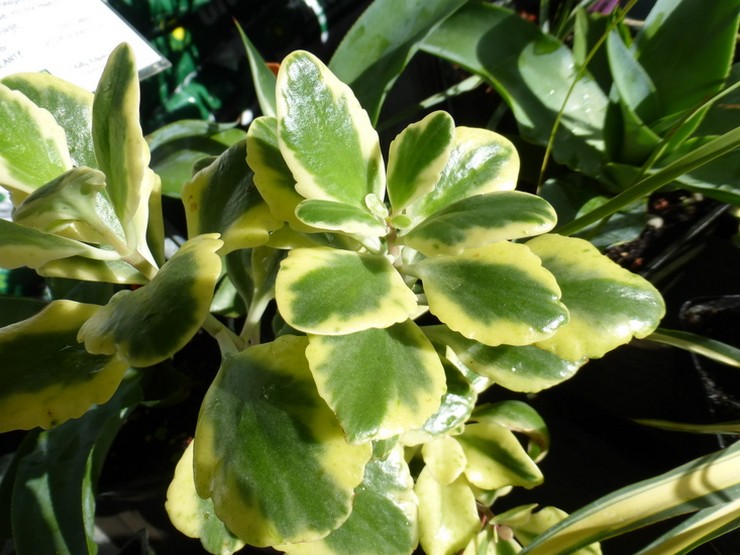
The species is known as the glaucous Kalanchoe (Kalanchoe glaucescens). Plant height reaches 40 cm. The leaf plates become wider and larger closer to the top of the plant. The leaves are round green with a white tint around the edges. Orange flowers are collected in umbrella inflorescences.
Kalanchoe tubular (Kalanchoe tubiflora)
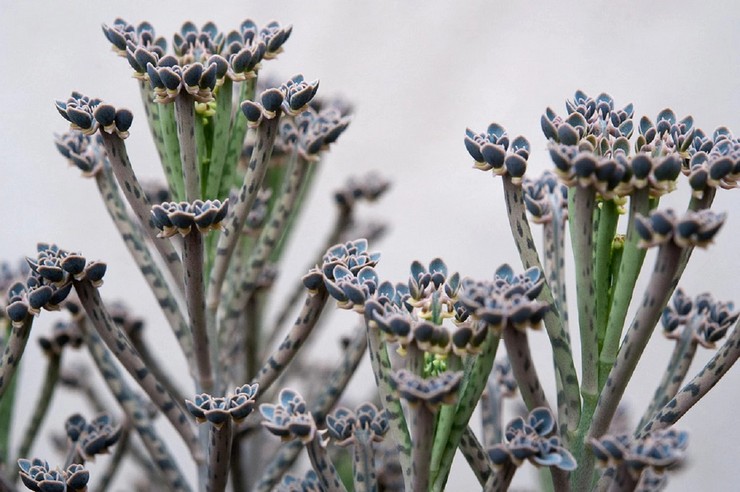
The species is represented by dwarf shrubs, reaching a height of 70 cm. Leaf plates of gray-green color, narrow, elongated. The leaves of the plant are strewn with brown spots.
Kalanchoe dissected (Kalanchoe laciniata)
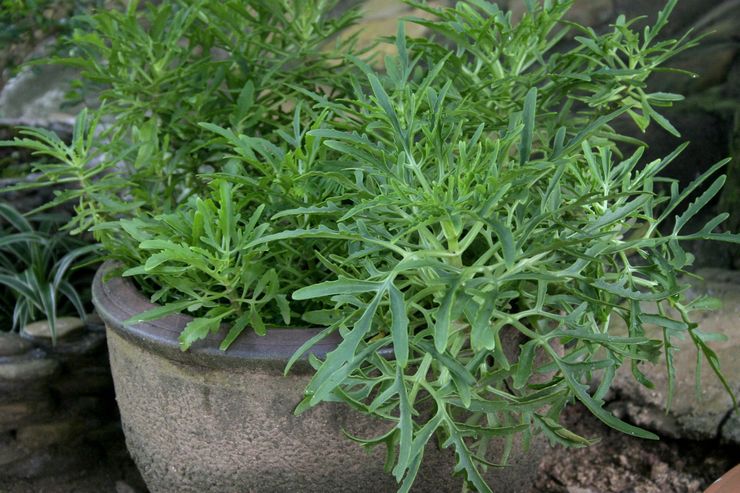
The species is also known as lobular Kalanchoe. The stems of the plant eventually sink down under their own weight, shedding leaves at the base. Green leaves have a dissected shape. Flowers are yellow or orange.
Kalanchoe Kalandiva
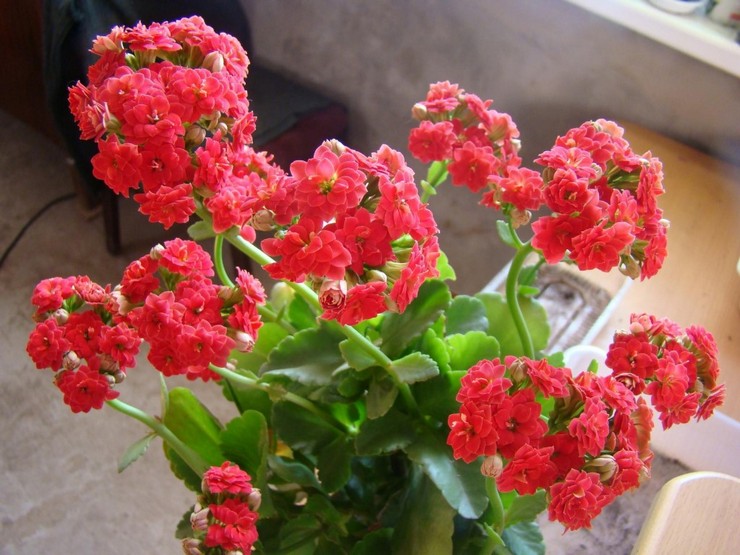
The species was obtained by selection. Differs in modest size and six-month flowering period.
The Kalanchoe plant is easy to care for at home, even beginners can do it. Subject to certain rules, the flower will constantly delight with its appearance and beauty.
Cacti and Succulents Houseplants

